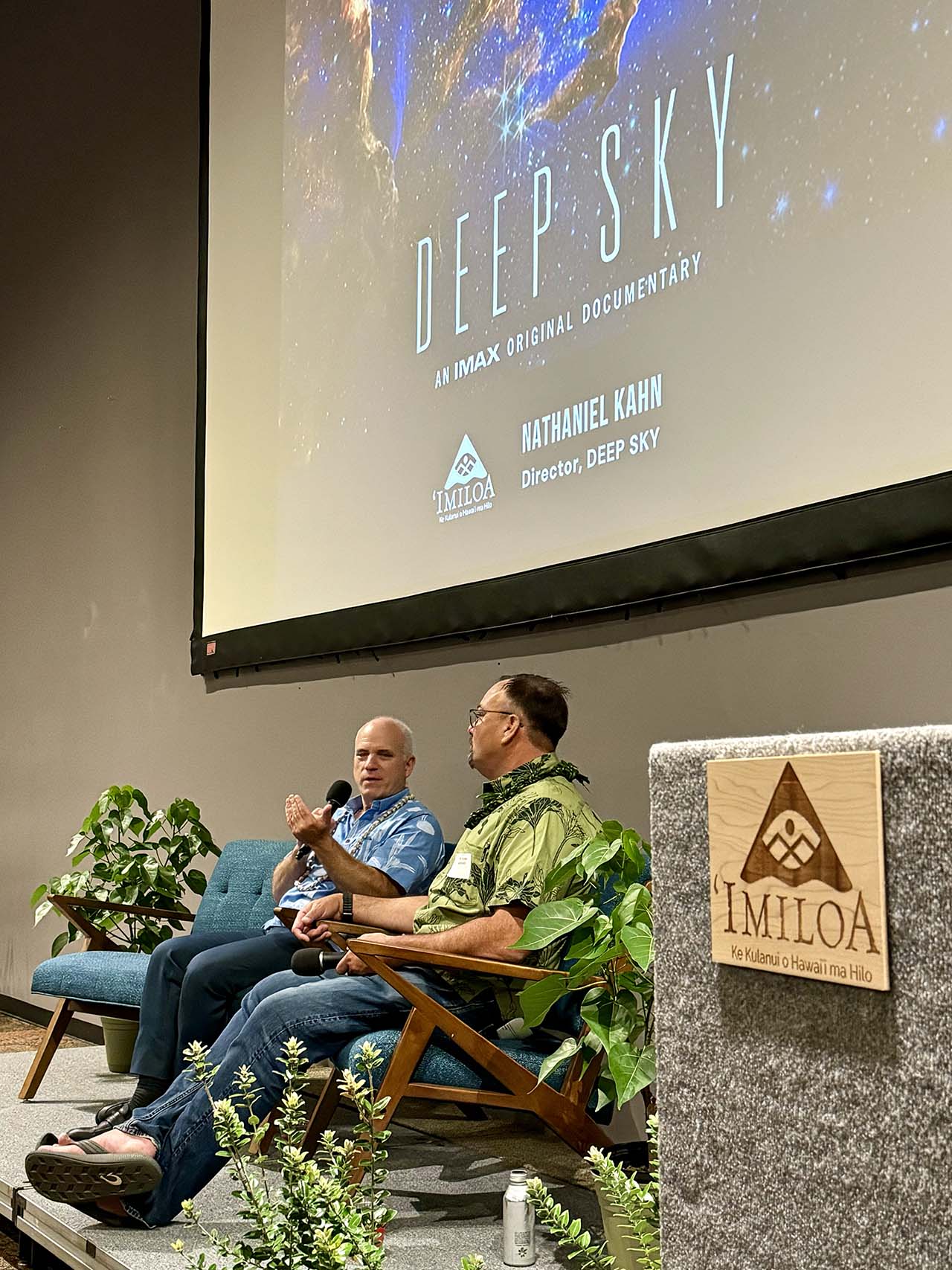Sharing “Deep Sky” in Hawai’i

Nathaniel Kahn and Na’alehu Anthony answer questions after the
Deep Sky movie screening at the ‘Imiloa Astronomy Center in Hilo, Hawai’i.
For millennia, the night sky has inspired us to ponder profound questions: How did our Universe begin? Where do we come from? Are we alone? Our curiosity drives us to undertake ambitious projects in search of answers. NASA’s James Webb Space Telescope (JWST) is one such big project: made possible by the collaboration of thousands of people from across the globe and across decades, to make their dream a reality. Their stories, and their efforts to complete this remarkable telescope and launch it into space, were captured by the stunning documentary and IMAX experience, “Deep Sky,” created by award-winning and Oscar-nominated director, Nathaniel Kahn.
In late September, Kahn traveled to Honolulu and Hilo to share the inspiring “Deep Sky” stories with the Hawai’ian community; educators, students, artists, voyagers, business leaders, and policymakers, along with astronomers, engineers, and technicians in three private screenings of Deep Sky, made possible through generous donations. The film follows JWST construction and launch, and shares – in the immersive IMAX format – the first scientific results. The screenings were followed by audience discussions with Nathaniel Kahn and Hawai’ian filmmaker and voyager, Na’alehu Anthony.
Through the experiences of the scientists and engineers who represent some of the 20,000 people who built and launched JWST, the movie tells the story of how this telescope and its most memorable images came to life. The now iconic images like the JWST Deep Field, the Pillars of Creation, and the Cosmic Cliffs, among others, are used to explore the scientific questions JWST was built to answer about the origin of the Universe, our place in it, and whether life exists beyond Earth. The film shares the emotional impact these results had on the scientists and engineers seeing these images for the first time.
“To be able to share “Deep Sky” with audiences in Hawai’i was a very moving experience,” commented Kahn. He continued, “There is nowhere on the planet where the stars are clearer and more beautiful than here, and it was those stars that first led humans to the islands more than a thousand years ago. The astronomers of today are following in the footsteps of those brilliant celestial navigators of the past – you really feel that when you look up at the night sky in Hawai’i.”
In the discussions following the screenings, the audience learned how Kahn was drawn into this story of JWST. As he followed the teams for over ten years, he captured how this was a profound journey into the unknown for many of the participants, who devoted decades to the project and yet were never truly sure whether JWST would even work. Kahn explained how astronomy, and building complex machines like JWST, can humble and move us.
There is a local connection to “Deep Sky”: some of the key technologies that enabled JWST – from infrared detectors to segmented mirrors – were pioneered in Hawai’i. At the Hawai’i screenings, many attendees asked questions about the role of Maunakea, how JWST was launched, and the audience discussed how much more there still is to learn that is even beyond the power of a telescope like JWST.
Nathaniel and Na’alehu also reminded the audience that Maunakea is unique, not just for science, but also for our environment. They described how the critically endangered Palila, a bird found only on the upper slopes of Maunakea, is challenged by climate change to inhabit an ever-decreasing ring around the Mauna and that the Palila embodies the importance of place and the fragility of Earth. Returning at the end of the discussion to Maunakea, they noted the central role the Mauna has in the culture of Hawai’i as the spiritual center of the Hawai’ian people.
Na’alehu and Nathaniel encouraged the audiences to look at what all the people had collectively achieved on JWST, driven simply by an idea. They challenged everyone – especially the children – to follow their curiosity, which will sometimes lead them over the horizon into the unknown. Na’alehu reminded us that one of our strengths in Hawai’i is the ability to tell stories, both of our past and for our future: whether through filmmaking, working in communities to understand our place on this fragile planet, or searching for life elsewhere.
Mahalo nui to ‘Imiloa Astronomy Center, W.M. Keck Observatory, TMT, Northrop Grumman, the University of Hawaii, and Maunakea Observatories for making these events possible.
About the Film
“Deep Sky” brings the awe-inspiring images captured by NASA’s Webb Telescope to IMAX® — taking audiences on a journey to the beginning of time and space, to never-before-seen cosmic landscapes, and to recently discovered exoplanets, planets around other stars. Directed by Oscar®-nominated filmmaker Nathaniel Kahn and narrated by Oscar®-nominated actress Michelle Williams, Deep Sky follows the high-stakes global mission to build JWST and to launch it into orbit one-million miles from Earth, in an attempt to answer questions that have haunted us since the beginning of time: Where did we come from? How did the universe begin? Are we alone? 13 billion years in the making, Deep Sky reveals the universe as we have never seen it before; immersing audiences in the stunning pictures beamed back to earth by NASA’s new telescope — and capturing their vast beauty at a scale that can only be experienced on the giant IMAX screen.
